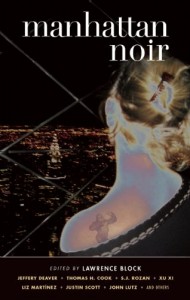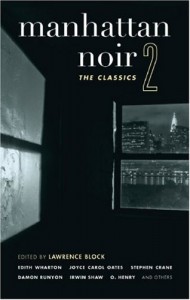The professional backwater of anthologist is ideal for an antiquated scribbler. I get to add new books to the shelves, with all the attendant ego gratification that my name on a book cover still provides me, but am spared the need to sit down and actually write something. (That’s the lure, anyway. More often than not an anthology winds up being twice the work of writing a novel, and the cash reward is, um, minimal.)
Lately I’ve been working on a new anthology, and I’d love to tell you all about it. I came up with a theme that really excited me—and it proved equally exciting for the seventeen outstanding fictioneers who’ve agreed to write brand-new stories for it. Several top publishers, here and across the pond, are similarly enthusiastic, and come September you’ll be able to buy a copy. (Which should be perfect timing, in that you’ll get to preview it for yourself before you load up on extras for holiday gifting.)
Did I miss something? Like, what’s the title and what’s the theme and who’s the publisher? And who are the writers?
I wish I could tell you. See, I don’t want to scoop the publisher by making the announcement ahead of schedule. And superstition keeps me from bragging on the various contributors until I have their stories in hand. But a third of them have already delivered, and I’ve read their stories, and I’m crazy about them, so I can tell you that the book will include extraordinary new work by Warren Moore, Joe R. Lansdale, Jill D. Block, Robert Olen Butler, and Joyce Carol Oates. And I’ve written a story myself, but it would hardly be meet for me to contend that it’s extraordinary.
Oh, right. Suddenly the air thickens with the effluvium of false modesty.
It’s the only kind I have. But you’re probably wondering why I brought up the subject when I’ve got so little to tell you, and that’s because an earlier anthology of mine just got a very satisfying review, and it’s my pleasure to share it with you.
 Some years back I edited Manhattan Noir for Akashic’s iconic series, and followed it with Manhattan Noir 2: The Classics. The second book, consisting entirely of reprints, was far more work for me, as I had to dig up the stories. (And they had to be in Manhattan. It took me ages to turn up a Jerome Weidman story I recalled vividly from when I read it half a century ago, and then it turned out to be set in Brooklyn. Still a great story, but not for that collection; happily, I found another Weidman tale that fit.)
Some years back I edited Manhattan Noir for Akashic’s iconic series, and followed it with Manhattan Noir 2: The Classics. The second book, consisting entirely of reprints, was far more work for me, as I had to dig up the stories. (And they had to be in Manhattan. It took me ages to turn up a Jerome Weidman story I recalled vividly from when I read it half a century ago, and then it turned out to be set in Brooklyn. Still a great story, but not for that collection; happily, I found another Weidman tale that fit.)
I included three poems while I was at it—by Poe, as you might expect, and by Horace Gregory and Geoffrey Bartholomew, as you might not. I happened on Edith Wharton’s first published story, and discovered it was a crime story—who knew? Suffice it to say that I did a lot of reading, turned up some terrific stories, and have always been slightly dismayed by the fact that MN2 has never sold as well as its predecessor. I guess that’s to be expected, I guess new work has an easier time finding an audience, but I wanted to grab people by the arm and tell them to buy this book.
Instead, I’ll let Pushpak Karnick do the grabbing:
 New York City, the Big Apple, is undoubtedly one of the most interesting cities in the world. The financial and cultural hub of the USA, NYC has a personality that is at once recognizable and utterly impossible to pin down. Perhaps, James Baldwin captured this fascination aptly when he compared all other cities of the world as a mistake or a fraud to the eyes of a native denizen. The skyline of this city is such an all-pervasive presence in pop culture that someone who has never been there can yet recognize the landmarks towering over the horizon. Our fascination with this most identifiable icon of urban landscape is not a modern phenomenon, but can be traced to the past century or beyond.
New York City, the Big Apple, is undoubtedly one of the most interesting cities in the world. The financial and cultural hub of the USA, NYC has a personality that is at once recognizable and utterly impossible to pin down. Perhaps, James Baldwin captured this fascination aptly when he compared all other cities of the world as a mistake or a fraud to the eyes of a native denizen. The skyline of this city is such an all-pervasive presence in pop culture that someone who has never been there can yet recognize the landmarks towering over the horizon. Our fascination with this most identifiable icon of urban landscape is not a modern phenomenon, but can be traced to the past century or beyond.
Manhattan has been the playground of imagination for writers, poets, artists and philosophers from all walks of life, irrespective of the time period. The skyscrapers, the gargoyles guarding (or are they watching?) over the pavements, the characteristic odor of freshly baked dough, mixed with sweat, the warm oily sheen of the subway, the continuous flux of humans like words flowing through stories, the idyllic expanse of Central Park – have all served as inviting backdrops to numerous literary works. Lawrence Block has collected together a fabulous collection of dark literature, prose and poetry, from such a time. Although the term noir is a very modern labeling of a particular style of fiction, the collection transcends any stylistic limitation and focuses on the essence of noir – exploring the darkness surrounding, and within, the characters and their environment.
Including fiction from the likes of Edith Wharton, Irwin Shaw, O. Henry (personal favorite), Edgar Allan Poe, to contemporary practitioners such as Geoffrey Bartholomew, Joyce Carol Oates, and a wonderful tale by Block himself (just so his mother would be proud!), this is a collection of fiction that explores the very definition of what constitutes noir. Reading through the stories and the poems chronologically, one can make two observations readily: first, one can sketch an imaginary arc of influence from the early works to the works in the new millennium, and secondly, the works reflect the social, economic, and cultural clouds that gathered over the famous skyline at the appropriate times in its history – “My Aunt from Twelfth Street” or “The Furnished Room” are two examples that come to mind.
So curl up with this delightful book in a cozy chair, with some hot cider (or something stronger, if you prefer) for company – but don’t forget to check the drapes! There might just be something surprising in the shadows…
